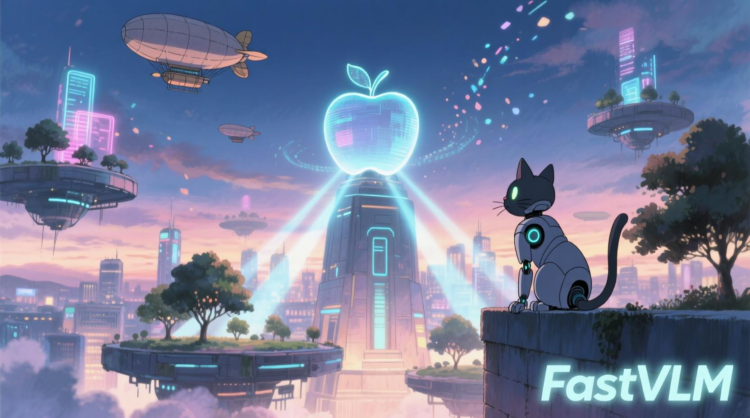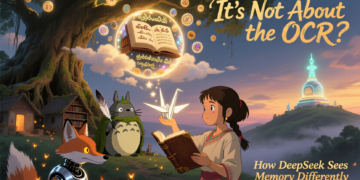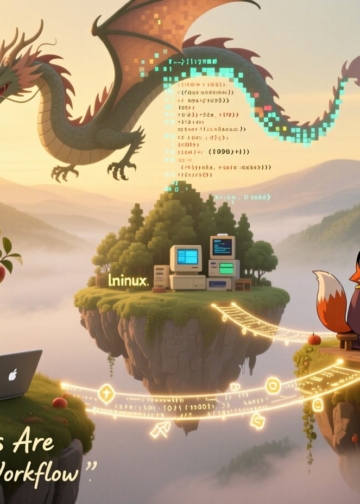Alright, tech fam, listen up. Drop whatever you’re doing.
For months, the entire internet has been screaming, “Apple is late to the AI party!” Well, it turns out they weren’t late. They were just building a rocket ship while everyone else was busy lighting firecrackers. And they just launched it. RIGHT on Hugging Face.
I’m not kidding. Apple, the walled garden company, just dropped a whole family of open-source Vision Language Models (VLMs), and they are UNBELIEVABLY fast. Say hello to the FastVLM family: tiny but mighty models at 0.5 billion, 1.5 billion, and 7 billion parameters, complete with quantized versions ready to rock on-device. This isn’t some quiet, dusty research paper release. This is a full-blown, developer-first A-bomb of a drop. We’re talking models, source code on GitHub, and a demo so good it feels like science fiction.
This is a massive signal. By planting their flag on Hugging Face, Apple is showing they’re serious about open research and empowering the community. They’ve released not just FastVLM but also the accompanying MobileCLIP2 models, showing this is part of a much bigger push.
But here’s the real kicker, the part that shows you this is a classic Apple 4D chess move. They didn’t just give us the model weights. They gave us the entire pipeline. The GitHub repo is packed with PyTorch checkpoints for the researchers, MLX-compatible formats for the Apple Silicon die-hards, and even a full-fledged sample iOS and macOS app to show you exactly how to build with it. This isn’t just a gift; it’s a strategic invitation. Apple’s main game is selling shiny hardware, and they know the next trillion dollars will come from killer AI apps running on that hardware. By releasing a model that is perfectly optimized for their chips and giving developers the exact tools to use it, they are building the foundation for their “Apple Intelligence” ecosystem. FastVLM isn’t a shot at GPT-4o; it’s a foundational block for the next generation of apps that will make you need an M-series Mac or the next iPhone. It’s a masterclass in ecosystem building.
Okay, So What IS FastVLM? And Why Should You Care?
Let’s cut the jargon. A Vision Language Model, or VLM, is an AI that can look at a picture and talk about it. Simple, right? You show it a photo of your dog, and it says, “A cute golden retriever is chasing a red ball on the grass.” The problem is, most VLMs are SLOW. Painfully slow. Especially when you feed them big, high-resolution images.
There’s a massive delay between the moment the AI “sees” the image and the moment it spits out the first word. In the biz, we call this Time-to-First-Token (TTFT), and it is the mortal enemy of any real-time application. This delay is caused by two bottlenecks: first, the vision encoder takes a long time to process the image into a format the language model can understand. Second, high-res images create a TON of these “visual tokens,” and the language model has to chug through all of them before it can even start generating a response.
FastVLM was designed with one single, glorious mission: to absolutely OBLITERATE TTFT.
And obliterate it does. We are talking speeds up to 85 TIMES FASTER than comparable models like LLaVA-OneVision, with a vision encoder that’s 3.4 times smaller. Let that sink in. Not 85% faster. 85x.
Why is this a BFD? Because this speed is the difference between a clunky, useless gimmick and a truly interactive AI that can see, understand, and react to the world as it happens. This is the tech that enables an AI assistant to understand what’s on your screen right now. It’s what allows for real-time accessibility tools that can describe a person’s surroundings to them instantly. The community immediately saw this potential, with discussions lighting up about how this could be life-changing for the visually impaired. This isn’t just a performance metric; it’s the key that unlocks the future of human-computer interaction that Apple has been teasing with its “Apple Intelligence” demos.
The Secret Sauce: How Apple Made It SO. DAMN. FAST.
So, what’s the magic behind this insane speed? The hero of this story has a name: FastViTHD. This isn’t your standard-issue Vision Transformer (ViT). It’s a “hybrid convolutional-transformer architecture”.
Kya bol raha hai, bhai? (What are you saying, bro?)
Think of it like a tag team.
- Convolutional Neural Networks (CNNs): These are the sprinters. They are incredibly fast and efficient at the initial grunt work of processing raw pixels and recognizing basic shapes and textures. They’re the opening act that gets the crowd warmed up.
- Transformer Layers: These are the master strategists. They are amazing at understanding the big picture how all the different parts of an image relate to each other to form a coherent scene. But this deep thinking is computationally expensive.
FastViTHD uses a brilliant hybrid approach. It lets the speedy CNNs do the initial heavy lifting, processing the high-resolution image through a convolutional stem and three convolutional stages. They quickly digest the image and create a compact, information-rich summary. ONLY THEN does it pass this much smaller, more manageable summary to the two final transformer stages for the deep contextual analysis.
The key innovation here is that this architecture is designed from the ground up to produce fewer, higher-quality visual tokens for the Large Language Model (LLM) to process. By drastically reducing the amount of data the LLM has to pre-process, it slashes the TTFT. It’s the definition of working smarter, not harder. What’s more, this elegant design completely eliminates the need for the complex, hacky “token pruning” or “merging” techniques that other models use to speed things up, making FastVLM much simpler to deploy. This isn’t just a research breakthrough; it’s what one commenter on Hacker News perfectly described as “good product engineering”. It’s a practical, elegant solution to a real-world problem pure Apple DNA.
Benchmarks Don’t Lie: Crushing the Competition.
Talk is cheap, so let’s get to the numbers. Apple didn’t just claim FastVLM was fast; they published the receipts for everyone to see. Across a whole suite of tough academic benchmarks from reading text in documents with TextVQA and DocVQA to complex scientific reasoning with ScienceQA and MMMU FastVLM consistently delivers top-tier performance.
The numbers speak for themselves. The smallest 0.5B model punches way above its weight, and the 7B model goes toe-to-toe with models that are much larger and slower.
- vs. LLaVA-OneVision (0.5B LLM): FastVLM is 85x faster in TTFT with a 3.4x smaller vision encoder, while scoring better on key benchmarks like SeedBench, MMMU, and DocVQA.
- vs. ConvLLaVA (7B LLM): FastVLM is 22% faster while achieving a massive 12.5% improvement on DocVQA and an 8.4% improvement on TextVQA.
- vs. Cambrian-1 (8B LLM): FastVLM is a staggering 7.9x to 21x faster while outperforming it on accuracy.
- vs. SmolVLM (~0.5B LLM): FastVLM is 5.2x faster.
To make it crystal clear, here’s a showdown table. Notice how it’s not just about accuracy; it’s about the insane speed you get with that accuracy.
Table 1: FastVLM vs. The World – Speed & Smarts Showdown
Model | LLM Size (Approx.) | TTFT Speedup (vs. Baseline) | VQAv2 | TextVQA | DocVQA | MMMU |
FastVLM-0.5B | 0.5B | 85x (vs. LLaVA-OneVision) | 76.3 | 64.5 | 82.5 | 33.9 |
LLaVA-OneVision | 0.5B | 1x (Baseline) | N/A | N/A | Lower | Lower |
SmolVLM | ~0.5B | 5.2x slower than FastVLM | N/A | N/A | N/A | N/A |
FastVLM-7B | 7B | 7.9x (vs. Cambrian-1) | 80.8 | 74.9 | 93.2 | 45.4 |
Cambrian-1 | 8B | 1x (Baseline) | N/A | Lower | N/A | Lower |
ConvLLaVA | 7B | 1.22x slower than FastVLM | N/A | 66.5 | 80.7 | 35.1 |
Note: N/A indicates data was not available in the direct comparisons. “Lower” indicates that sources state FastVLM’s performance was superior.
This table tells the whole story. With FastVLM, you no longer have to choose between speed and intelligence. You get both.
THE MAIN EVENT: Real-Time AI in Your BROWSER?! 🤯
Okay, now for the part that will absolutely blow your mind. This is the mic drop. Apple didn’t just publish code and models. They dropped a LIVE DEMO on Hugging Face Spaces that runs real-time video captioning directly in your browser.
NO INSTALL. NO SETUP. NO pip install. You open a URL, give your browser camera permission, and watch it describe your world in real-time. It’s so fast, you literally can’t read the captions as quickly as it generates them.
How is this black magic even possible? Two words: WebGPU.
For those who haven’t been following, WebGPU is the super-powered successor to WebGL. It’s a modern web API that gives web pages near-direct access to your computer’s GPU. This unlocks MASSIVE performance gains for graphics and, more importantly for us, the kind of parallel computations that AI models feast on. It’s the key that lets developers run heavy-duty AI models client-side, without needing a beefy server in the cloud. The demo’s own source code confirms this, with an initial check for navigator.gpu to ensure your browser is ready for the magic.
This isn’t some future-tech; it’s here now. WebGPU is shipping in modern versions of Chrome and Edge, and it’s enabled by default in Firefox Nightly and Safari Technology Preview. On some platforms like Linux, you might need to flip a flag, but it’s rapidly becoming the standard.
This web demo is a stroke of genius. It’s the ultimate “show, don’t tell.” Why read a benchmark table when you can experience real-time AI with a single click? It’s a frictionless demonstration that instantly communicates the value of FastVLM. But more than that, it’s a strategic move to normalize the idea of powerful, on-device AI running in the browser. It’s the perfect hook to get developers excited, pull them into the GitHub repo, and get them thinking about building the next great AI app preferably, a native one for iOS using MLX.
ENOUGH TALK. Let’s Get Our Hands Dirty!
Theory is great, but we’re builders. It’s time to stop talking and start running this beast ourselves. I’m giving you the exact, no-fluff, copy-paste-ready commands. Let’s do this.
Try the WebGPU Demo RIGHT NOW.
- Browser Check: First things first. Make sure you’re on a modern desktop browser that supports WebGPU, like the latest versions of Chrome, Edge, or Firefox Nightly.
- Open the Magic Link: Head over to the Hugging Face Space:
https://huggingface.co/spaces/apple/fastvlm-webgpu. - Grant Permission: The app needs to see the world, so it will ask for camera access. Click “Allow”.
- Troubleshooting 101: If it hangs or gives an error, don’t panic. Check your browser’s site permissions to make sure the camera isn’t blocked. Ensure no other app (like Zoom or Google Meet) is hogging your webcam. A simple page refresh often does the trick.
- Enjoy the Future: Point your camera at anything around you your keyboard, your coffee mug, your face and watch the live captions roll in. Welcome to the future.
Run It Locally on Your Mac (The MLX Way).
Ready to go deeper? Let’s get this running locally on your own machine.
Prerequisites: You’ll need a Mac with Apple Silicon (M1, M2, M3, etc.). This whole thing is optimized for their hardware, remember? You’ll also need a standard Python 3 installation.
Step 1: Clone the Official Repo.
Fire up your terminal and let’s get the source code.
# Let's get this party started!git clone https://github.com/apple/ml-fastvlm.gitcd ml-fastvlmStep 2: Set Up Your Python Environment.
Pro tip: ALWAYS use a virtual environment. It keeps your global Python installation clean and prevents dependency hell.
# Best practice, always.python3 -m venv venvsource venv/bin/activate# Install the required packagespip install -r requirements.txtStep 3: Download the Model Checkpoints.
The Apple team included a handy script to download all the pre-trained models. This is a big download, so now is a great time to go grab some chai ☕.
# This will download several gigabytes of model files.# Be patient, greatness takes time.bash get_models.sh# The models will be saved into a new 'checkpoints' directory.Step 4: Run Inference!
The official repo uses the LLaVA codebase for its training and inference logic.4 While you should check the
README for the most up-to-date and detailed instructions, here is a representative Python script to show you how you’d typically run inference with a model like this.
# DISCLAIMER: This is a simplified, illustrative script.# The official repo contains more detailed instructions and a full iOS/macOS app.# Always refer to the official documentation at https://github.com/apple/ml-fastvlm# This example assumes you have MLX and other dependencies installed.# You would typically use the inference scripts provided in the repo,# which are built on the LLaVA framework.# For a real-world example, check out the Swift code in the 'app' directory# of the official GitHub repository!print("To run inference, please follow the detailed instructions")print("and use the provided scripts in the official GitHub repository.")print("They provide a full iOS/macOS demo app to showcase the model's power!")FastVLM FAQ – What People Are Really Asking
1. What is FastVLM, and why is it so fast?
FastVLM is Apple’s brand‑new open‑source Vision–Language Model that pairs images and text but with some serious speed magic. Its secret weapon is FastViTHD, a hybrid vision encoder that processes high‑res images quickly by creating fewer, richer tokens sent to the language model. The result? A Time‑To‑First‑Token (TTFT) that’s up to 85× faster than models like LLaVA‑OneVision, with similar or better accuracy all while using a vision encoder that’s 3.4× smaller.
2. How does FastVLM stack up against models like LLaVA or Cambrian-1?
It blows them out of the water in latency without giving accuracy away. On a 0.5B LLM, FastVLM is 85× faster than LLaVA‑OneVision while being more compact.
Meanwhile, paired with a Qwen2‑7B LLM, FastVLM outpaces Cambrian‑1‑8B with 7.9× faster TTFT and superior performance on benchmarks like DocVQA and TextVQA all using just one image encoder.
3. Can FastVLM actually run on your device, like an iPhone or Mac?
Absolutely this is one of its most exciting features. Apple released a live WebGPU demo that runs in your browser via Hugging Face Spaces no setup, no installs just camera access, and real‑time AI captioning. And yes, it works on your iPhone or Mac GPU, all on device, safeguarding your privacy.
4. How easy is it to use or try FastVLM yourself?
Super smooth. You can clone the GitHub repo, set up a Python 3.10 environment, run bash get_models.sh to grab the checkpoints, and you’re ready to roll with predict.py. If you’re on Apple Silicon, simply export the models into the proper MLX-compatible formats and follow the iOS/macOS demo in the repo.
5. Why is FastVLM such a big deal for accessibility?
This one hits close to home. On Reddit, a user remarked how fast the model runs with screen reader setups like mascara tipping your phone enables braille input and it’s mind-blowing for visually impaired users. Performance like this opens doors for real-time, private, and seamless descriptions and navigation tools.
6. Does it work equally well with blurry or low-resolution images?
FastVLM shines especially with high-resolution inputs, thanks to FastViTHD. While low-res images might lead to less detailed outputs, FastVLM maintains top accuracy and speed even with bigger images it was designed for that sweet spot.
7. Is Apple really giving this away but with limitations?
Yes and no. The code, models, and demos are generous, developer-friendly, and open-sourced via GitHub and Hugging Face. That said, Apple does label it under their Research-Only License, so it’s savvy to review the terms especially if you plan to modify, deploy, or commercialize.
8. How did Apple pull off such speed gains without being a research gimmick?
The trick was smart product engineering: three convolutional stages followed by two transformer layers, aka FastViTHD. This hybrid approach quickly distills visual info into fewer, higher-quality tokens no need for clunky pruning tricks. It’s elegant, effective, and practical. As someone on Hacker News put it: “Three CNN layers with two transformer layers is just good product engineering.”
So, What’s Next? The Future is FAST.
Apple releases FastVLM and MobileCLIP2 on Hugging Face, along with a real-time video captioning demo (in-browser + WebGPU)
byu/xenovatech inLocalLLaMA
This release is so much more than just another model on a leaderboard. It’s a paradigm shift for what we can expect from AI on our personal devices. The developer community is already buzzing with game-changing ideas.
- Accessibility on Steroids: The most immediate and powerful application. Imagine real-time, private, and instantaneous environmental descriptions for the visually impaired, running entirely on their iPhone. This isn’t just a feature; it’s a life-changing tool that is now within reach.
- Creative and Productivity Tools: The request for a Lightroom plugin that can auto-caption and keyword an entire photo library in real-time is no longer a dream. Think automated document scanning, receipt organization, and intelligent photo search, all happening instantly and locally.
- Truly Smart Devices: This is the engine for the next generation of on-device assistants that can actually see and understand your screen, for robots that can navigate complex real-world spaces, and for fully interactive augmented reality experiences.
This move fits perfectly into Apple’s grand “Apple Intelligence” strategy. It’s built on their three core pillars:
- Privacy-First Architecture: By designing models that excel on-device, Apple ensures your personal data (your photos, your screen) stays on your device, period.
- Apple Silicon Optimization: FastVLM is tailor-made to scream on their custom M-series and A-series chips, creating a powerful hardware-software synergy.
- Developer Enablement: They are handing developers the keys to the kingdom. With Core ML, MLX, and now powerful open-source models like FastVLM and OpenELM, they are building an arsenal of tools to attract and retain the best developers in their ecosystem.
Apple is playing the long game here. They aren’t just trying to win the current AI race; they’re building their own private racetrack where their hardware has the ultimate home-field advantage. FastVLM is a loud and clear signal to the world: the future of AI isn’t just in a distant cloud. It’s in your pocket, it’s on your desk, it respects your privacy, and it’s going to be unbelievably, ridiculously fast.
Now, stop reading and go build something amazing. 🚀



















